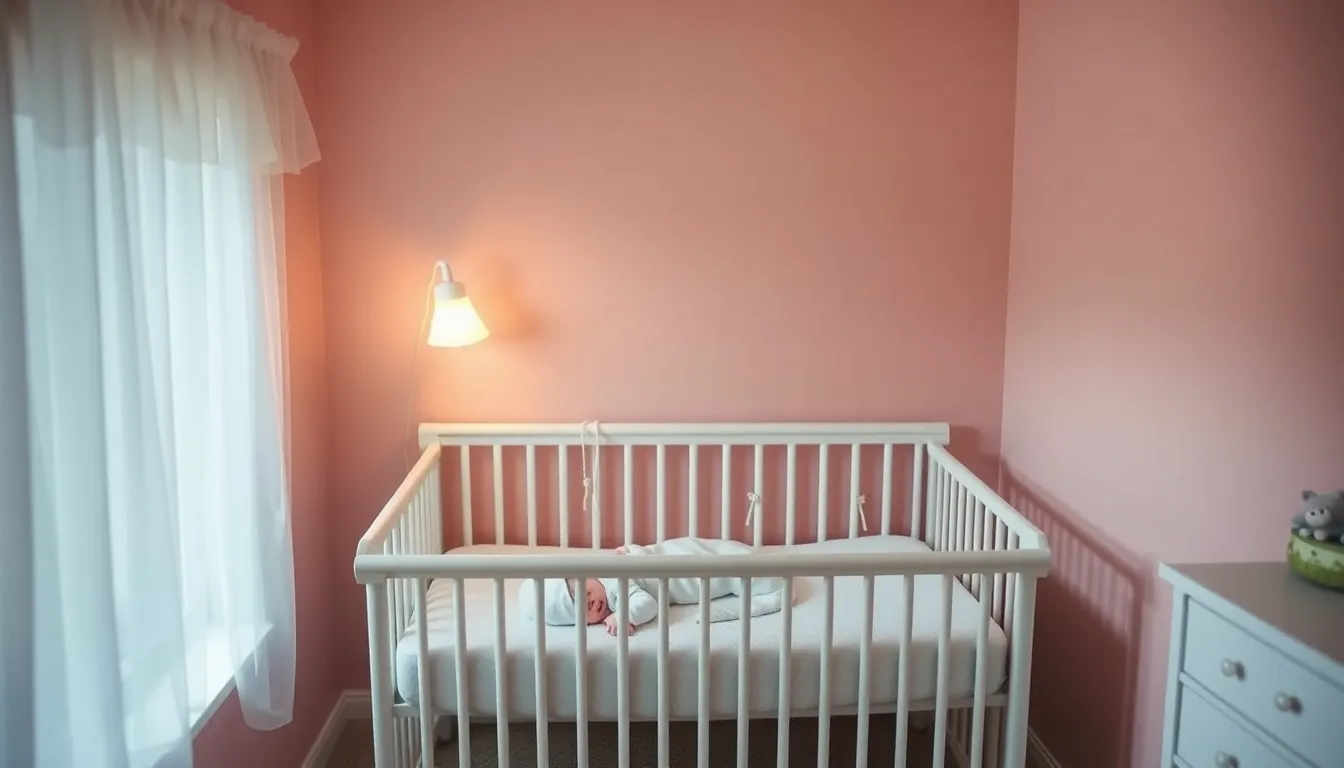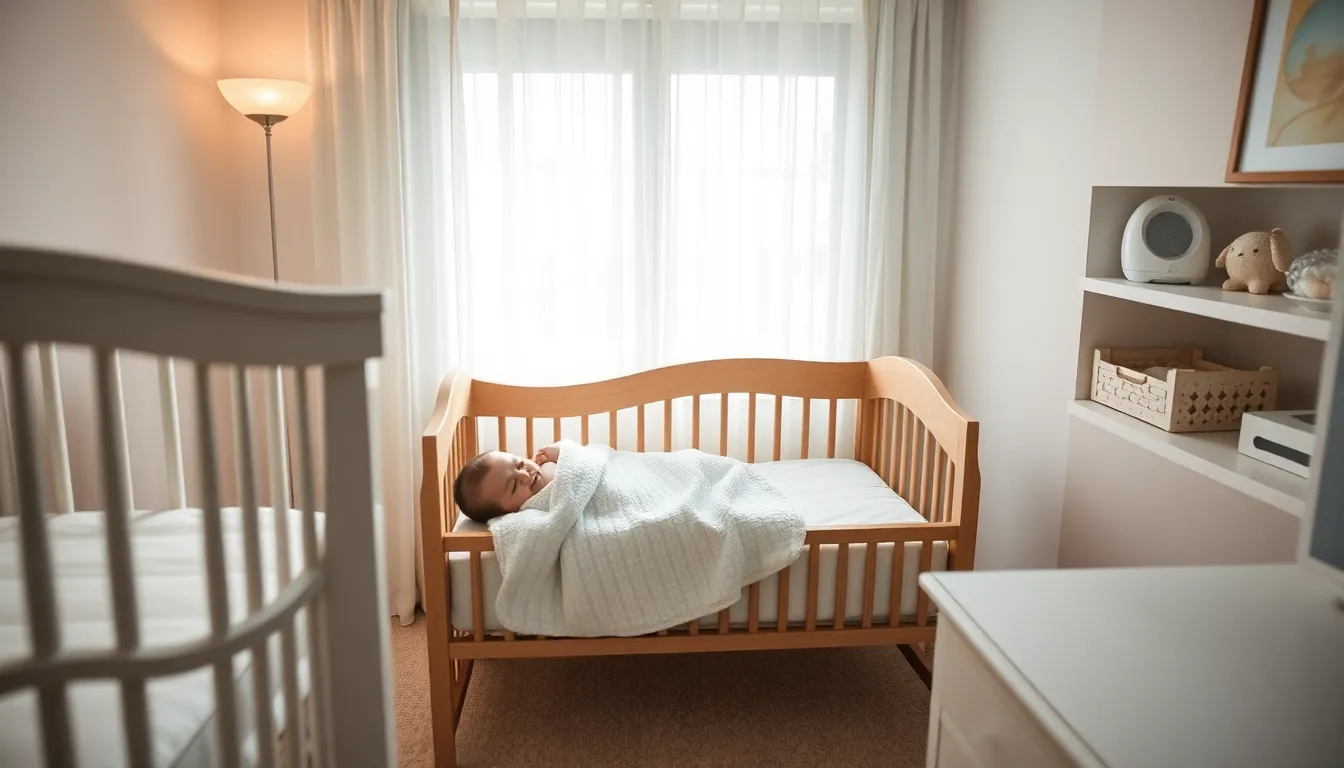Every new parent knows that sleep is a precious commodity, often more elusive than a unicorn. When it comes to baby sleep, it’s a game of trial and error, with many parents wondering if they’ve accidentally signed up for a sleep deprivation marathon. But fear not! With the right tips and tricks, it’s possible to turn those sleepless nights into peaceful slumbers.
Table of Contents
ToggleImportance Of Baby Sleep
Baby sleep plays a crucial role in an infant’s growth and development. Sleep supports physical growth, brain development, and emotional regulation in infants. Studies indicate that newborns require 14 to 17 hours of sleep daily, while toddlers need about 11 to 14 hours. Prioritizing a consistent sleep schedule helps establish healthy sleep habits.
Mental health benefits arise from adequate sleep. Babies experience mood swings and heightened irritability when sleep-deprived. Sufficient rest contributes to better temperament, reducing the likelihood of fussiness.
Moreover, sleep impacts cognitive abilities. Quality sleep fosters memory consolidation and enhances learning capacity. Research shows that infants exposed to regular sleep patterns exhibit improved attention spans and problem-solving skills.
Physical health also relies on proper sleep. Sleep deprivation in babies can lead to weight gain issues and weakened immune systems. Consistent sleep durations fortify immune responses, promoting overall wellness.
Parental well-being receives a boost from their baby’s sleep, too. Well-rested babies tend to experience fewer night awakenings, allowing parents to enjoy more restful nights. A well-rested parent can manage daily tasks more effectively, leading to a healthier family dynamic.
Creating an environment conducive to sleep enhances the benefits of rest. The right room temperature, low light levels, and minimal noise contribute to quality sleep. Establishing a bedtime routine establishes predictability, helping babies transition smoothly into sleep.
Recognizing the importance of baby sleep encourages parents to take actionable steps in promoting better sleep practices, ultimately fostering development and well-being for both child and parent.
Understanding Baby Sleep Patterns

Babies have unique sleep patterns that often puzzle new parents. Understanding these patterns helps caregivers support healthy sleep habits.
Newborn Sleep Cycle
Newborns follow a distinct sleep cycle characterized by shorter sleep periods. Each cycle lasts about 50 to 60 minutes, with infants spending roughly half of this time in REM sleep. REM sleep promotes brain development and is crucial for learning. They typically sleep between 14 to 17 hours a day, waking frequently for feeding and comfort. Parents should note that newborns may not distinguish between day and night initially, which adds to nighttime awakenings. Creating a calm sleep environment can help them transition toward longer sleep stretches over time.
Sleep Patterns By Age
As babies grow, their sleep patterns evolve significantly. By three months, infants may start to consolidate sleep into longer stretches, often 6 to 8 hours at night. This change correlates with their increasing ability to self-soothe. By six months, many babies can sleep through the night without feeding, requiring about 12 to 15 hours of sleep daily. Toddlers, aged 1 to 3 years, need around 11 to 14 hours, often taking one to two naps during the day. Tracking these changes ensures caregivers adapt bedtime routines to fit the child’s evolving needs.
Creating The Ideal Sleep Environment
An optimal sleep environment significantly enhances a baby’s ability to rest. Factors like temperature, noise levels, and lighting all play crucial roles.
Room Temperature
Maintaining a comfortable room temperature promotes restful sleep. Ideal temperatures for infants range from 68°F to 72°F (20°C to 22°C). A cooler room often helps babies fall asleep faster. Check for signs of overheating, such as sweating or flushed skin. Dressing babies in breathable fabrics ensures ventilation. Parents can use a room thermometer to monitor the environment easily.
Noise Levels
Creating a quiet atmosphere supports deeper sleep. Sudden loud noises can disrupt an infant’s rest. Using white noise machines can help mask disturbing sounds. Continuous soft sounds mimic the comforting environment of the womb. Parents should avoid sudden disruptions while the baby sleeps, ensuring consistent noise levels. Soft lullabies or ambient sounds can soothe babies as they drift off.
Lighting
Controlling lighting levels influences a baby’s sleep patterns. Soft, dim lighting signals that it’s time to wind down. Blackout curtains effectively block out bright outdoor light during daytime naps. Exposure to bright light in the morning helps babies understand day from night. Dimming lights during evening routines encourages relaxation and signals bedtime. Parents should prioritize creating a calm and soothing atmosphere.
Establishing A Bedtime Routine
Creating a structured bedtime routine helps babies transition smoothly from daytime activities to sleep. Consistency is key for reinforcing sleep signals.
Wind-Down Activities
Wind-down activities prepare newborns for sleep by promoting relaxation. Gentle activities include reading a short story, singing lullabies, or giving a warm bath. Engaging in calming behaviors aids in signaling that bedtime is approaching. Avoid stimulating games during this time, as they can be counterproductive. Activities that involve quiet time help babies learn to associate these routines with sleep.
Consistent Sleep Schedule
Maintaining a consistent sleep schedule significantly influences a baby’s sleep quality. Infants thrive on routine, so putting them to bed and waking them up at the same times daily fosters healthy sleep patterns. Establishing a predictable schedule encourages their bodies to adapt and recognize sleep cues. Aim for similar bedtime routines even on weekends to avoid disrupting established patterns. Over time, this consistency helps babies develop longer sleep stretches, contributing to their overall well-being.
Tips For Encouraging Independent Sleep
Encouraging independent sleep in babies requires thoughtful strategies. Incorporating safe sleep practices is fundamental.
Safe Sleep Practices
Safe sleep practices ensure a secure environment, promoting restful sleep. The American Academy of Pediatrics recommends placing infants on their backs to sleep. A firm mattress, free of soft bedding, toys, or pillows, reduces the risk of suffocation and Sudden Infant Death Syndrome (SIDS). Keeping the crib in the parents’ bedroom during the first six months enhances safety while allowing for easy monitoring. Optimal room temperature remains between 68°F to 72°F (20°C to 22°C) to reduce overheating. Using pacifiers at nap and bedtime may also lower SIDS risk. Adhering to these guidelines fosters a conducive environment for independent sleep.
Sleep Training Methods
Sleep training methods support babies in developing self-soothing skills. The Ferber Method involves allowing babies to cry for predetermined intervals before offering comfort. Another effective strategy is the No Tears Method, which emphasizes gentle guidance without letting the baby cry. Parents may also utilize the Chair Method, gradually distancing themselves from the crib while comforting their baby. Each of these methods can be tailored to the baby’s temperament and needs. Consistency remains key, as regular sleep routines increase the likelihood of success. Choosing a sleep training method aligned with family values can significantly enhance baby sleep patterns.
Finding effective baby sleep tips can significantly improve both a child’s and parents’ quality of life. By understanding sleep patterns and establishing a consistent bedtime routine, parents can create a nurturing environment that encourages restful sleep.
Implementing safe sleep practices and fostering independence in infants not only enhances their well-being but also supports their development. A calm atmosphere and structured schedules can transform sleepless nights into peaceful ones.
With patience and dedication, parents can navigate the challenges of baby sleep, ensuring a healthier and happier family dynamic. Embracing these strategies will ultimately lead to brighter days and restful nights for everyone involved.



